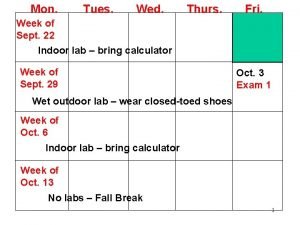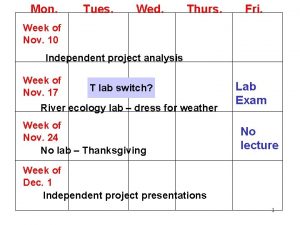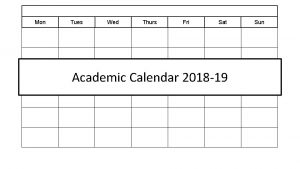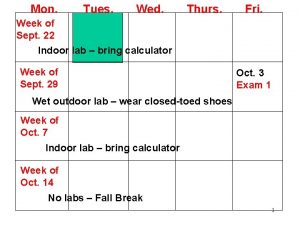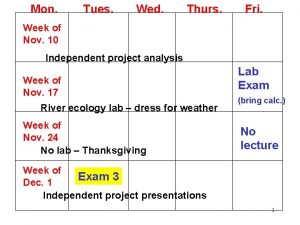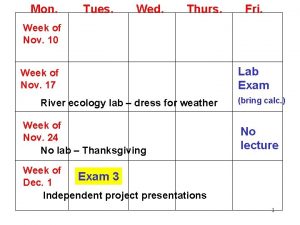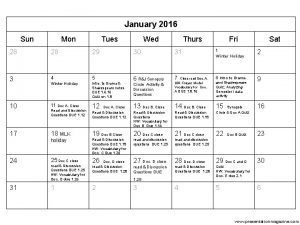Mon Tues Wed Thurs Fri Week of Sept






















- Slides: 22

Mon. Tues. Wed. Thurs. Fri. Week of Sept. 22 Indoor lab – bring calculator Week of Sept. 29 Oct. 3 Exam 1 Wet outdoor lab – wear closed-toed shoes Week of Oct. 6 Indoor lab – bring calculator Week of Oct. 13 No labs – Fall Break 1

Outline for organisms Introduction What do organisms need to survive and reproduce? How do organisms cope with variability? 2

Niche: ecological role of a species in the community - determines the range of conditions an organism can tolerate, how it feeds, how it escapes enemies, etc. - no two species have the same niche 3

Habitat: the physical setting in which an organism lives 4

Outline for organisms Introduction What do organisms need to survive and reproduce? How do organisms cope with variability? 5

Fig. 9. 4 6

How do organisms cope with variability? behavioral adaptations physiological adaptations developmental adaptations 7

behavioral - organisms can alter their behavior to stay within range of environmental conditions required to survive and reproduce 8

preferred temp. 9

10

physiological - the physiology of an organism can change such that the range of environmental conditions it can tolerate changes - reversible - acclimation 11

Figure 9. 9 12

Figure 9. 10 blue = grown at 20 C orange = grown at 40 C 13

How do organisms cope with variability? behavioral adaptations physiological adaptations developmental adaptations 14

developmental - particular traits of an organism may be affected by the environmental conditions under which it develops - irreversible 15

16

Surviving extreme conditions For example, long, cold winters or long, very dry seasons 17

Outline for organisms Introduction and review of adaptation What do organisms need to survive and reproduce? How do organisms cope with variability? -example of variability in food resources 18

optimal foraging theory – organisms will forage in a way that maximizes energy intake per time while minimizing risk In lab – had to forage in way that maximized bean capture and minimized getting tagged by predator 19

Figure 9. 16 20

Do starlings forage optimally? Figure 9. 18 21

Should an organism risk predation to forage in an area with a lot of food? Figure 9. 19 22
 Mon tue wed thurs fri sat sun
Mon tue wed thurs fri sat sun Sun-mon
Sun-mon Mon tues wed thurs fri sat sun
Mon tues wed thurs fri sat sun Mon tues wed thurs fri
Mon tues wed thurs fri Sat sun mon tue wed thur fri
Sat sun mon tue wed thur fri Mon tues wed
Mon tues wed Mon tues wed thurs fri
Mon tues wed thurs fri Wed thurs
Wed thurs Wed thurs fri
Wed thurs fri Mon tue wed thu fri
Mon tue wed thu fri Mon tues wed thurs fri sat sun
Mon tues wed thurs fri sat sun Mon tues wed thurs fri
Mon tues wed thurs fri Mon tue wed thur fri
Mon tue wed thur fri Mon tues wed thurs fri
Mon tues wed thurs fri Thu fri sat sun
Thu fri sat sun Sun mon
Sun mon Mon to thu
Mon to thu Mon wed
Mon wed Mon tue wed thurs fri sat sun
Mon tue wed thurs fri sat sun Sun mon tue wed thu fri sat
Sun mon tue wed thu fri sat Tue-thu
Tue-thu Xxxxxx 2016
Xxxxxx 2016 Wed thr
Wed thr





